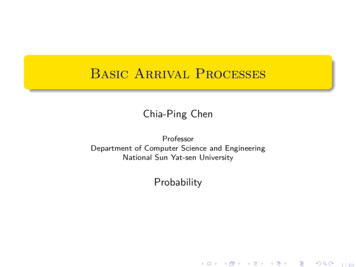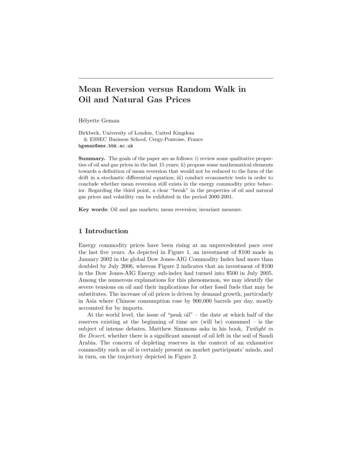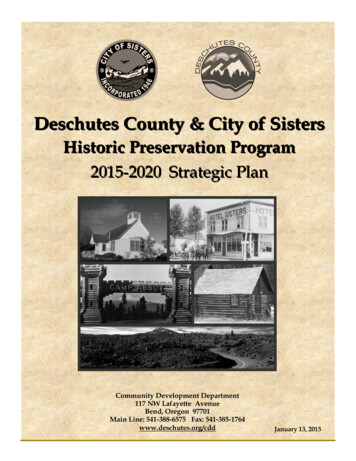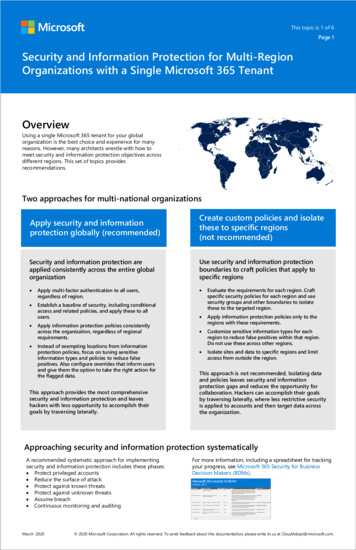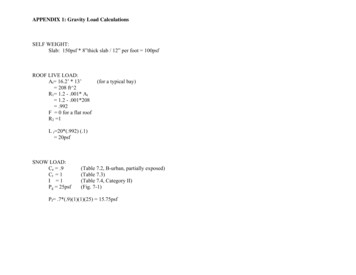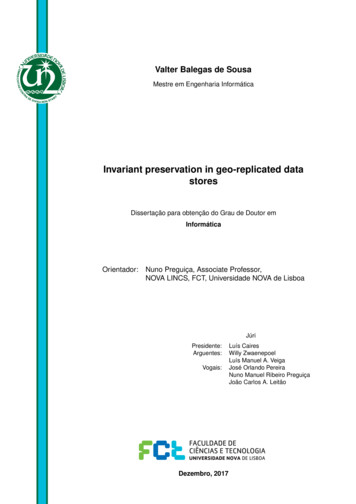
Transcription
Valter Balegas de SousaMestre em Engenharia InformáticaInvariant preservation in geo-replicated datastoresDissertação para obtenção do Grau de Doutor emInformáticaOrientador:Nuno Preguiça, Associate Professor,NOVA LINCS, FCT, Universidade NOVA de LisboaJúriPresidente:Arguentes:Vogais:Dezembro, 2017Luís CairesWilly ZwaenepoelLuís Manuel A. VeigaJosé Orlando PereiraNuno Manuel Ribeiro PreguiçaJoão Carlos A. Leitão
Invariant preservation in geo-replicated data storesCopyright Valter Balegas de Sousa, Faculdade de Ciências e Tecnologia, UniversidadeNOVA de Lisboa.A Faculdade de Ciências e Tecnologia e a Universidade NOVA de Lisboa têm o direito,perpétuo e sem limites geográficos, de arquivar e publicar esta dissertação através deexemplares impressos reproduzidos em papel ou de forma digital, ou por qualquer outromeio conhecido ou que venha a ser inventado, e de a divulgar através de repositórioscientíficos e de admitir a sua cópia e distribuição com objetivos educacionais ou de investigação, não comerciais, desde que seja dado crédito ao autor e editor.Este documento foi gerado utilizando o processador (pdf)LATEX, com base no template “unlthesis” [1] desenvolvido no Dep. Informática da FCT-NOVA [2].[1] https://github.com/joaomlourenco/unlthesis [2] http://www.di.fct.unl.pt
Ac k n o w l e d g e m e n t sThis thesis was only possible with with the hard work of all the people that were involved in it. From this work, and time spent with it, I will take knowledge and personalexperiences for all my professional and adult life.First, and foremost, I want to thank my advisor, Nuno Preguiça, in the developmentof this work. Nuno was the best advisor that a student can get. He made an extraordinaryeffort to help me achieve my goals, and was always available to discuss and share ideas.He gave me the opportunity to be integrated in a large research group at an internationallevel, which was a game changer for my perspectives.I am also most grateful for having Sérgio Duarte and Carla Ferreira so close to meduring the past few years. Sérgio and Carla had a fundamental role in giving eleganceto this work. I would also like to highlight that I am grateful to Carla for trusting meand give me autonomy to work with her students in a later phase of my studies. RodrigoRodrigues was always very inspirational. He always contributed with a fresh view andprofound understanding of the work. Last but not least, I would like to thank MarcShapiro for the time we have spent discussing ideas with me, at a very early stage of mystudies. I have never seen anyone else that puts so much effort in understanding people’sideas — that is a gift.I am also thankful to José Orlando Pereira and Luis Caires for dedicating their time togive feedback and prepare me for the thesis defense. They had very insightful commentsthat helped me see my work in a wider spectrum. Likewise, I appreciate the time andavailability of the jury to participate in the defense.On a more personal note, I am grateful for establishing bonds with my office colleagues, whom I now call friends. I am very pleased to have met so many extraordinarypeople along the way and learn from other cultures. The following is a shortlist of people’s names that I met during this period and will remain forever in my heart: AlbertLinde, Alejandro Tomsic, Annette Bienusa, Bernardo Ferreira, Carlos Baquero, Cheng Li,Daniel Porto, David Navalho, Deepthi Devaki, Filipe Freitas, João Leitão, João Lourenço,João Silva, Jordi Martori, Manuel Bravo, Marek Zawirski, Ricardo Dias, Russell Brown,Tiago Vale, Zhongmiao Li.None of this would be possible without my parents Ana and Fernando Sousa, thatgave me everything so that I could reach this point in my life. It is impossible to retrieveor compensate for what they did, I can only aspire to one day be able to do for my childrenv
what they have done for me. At last, a word for Adelina, Angela, Bruno and my closestfriends: thank you for the patience, support and bringing joy to my life.At last, I would like to acknowledge the institutions that supported my research: Departamento de Informática of the Faculdade de Ciências e Tecnologia of the UniversidadeNOVA de Lisboa (DI-FCT-UNL) and the NOVA Laboratory of Computer Science andInformatics (NOVA LINCS) for hosting me and providing all the equipment and spacethat I required; Fundação para a Ciência e Tecnologia (FCT/MCTES) for awarding me ascholarship (SFRH/BD/87540/2012); and, finally, the research projects: EU FP7 SyncFreeproject (609551), SwiftComp project (PTDC/ EEI-SCR/ 1837/ 2012), Rodrigo Rodrigues’ERC Grant (307732)vi
A b s t r ac tThe Internet has enabled people from all around the globe to communicate with eachother in a matter of milliseconds. This possibility has a great impact in the way we work,behave and communicate, while the full extent of possibilities are yet to be known. As webecome more dependent of Internet services, the more important is to ensure that thesesystems operate correctly, with low latency and high availability for millions of clientsscattered all around the globe.To be able to provide service to a large number of clients, and low access latencyfor clients in different geographical locations, Internet services typically rely on georeplicated storage systems. Replication comes with costs that may affect service quality.To propagate updates between replicas, systems either choose to lose consistency in favorof better availability and latency (weak consistency), or maintain consistency, but thesystem might become unavailable during partitioning (strong consistency).In practice, many production systems rely on weak consistency storage systems toenhance user experience, overlooking that applications can become incorrect due to theweaker consistency assumptions. In this thesis, we study how to exploit application’ssemantics to build correct applications without affecting the availability and latency ofoperations.We propose a new consistency model that breaks apart from traditional knowledgethat applications consistency is dependent on coordinating the execution of operationsacross replicas. We show that it is possible to execute most operations with low latencyand in an highly available way, while preserving application’s correctness. Our approachconsists in specifying the fundamental properties that define the correctness of applications, i.e. the application invariants, and identify and prevent concurrent executions thatpotentially can make the state of the database inconsistent, i.e. that may violate someinvariant. We explore different, complementary, approaches to implement this model.The Indigo approach consists in preventing conflicting operations from executingconcurrently, by restricting the operations that each replica can execute at each momentto maintain application’s correctness.The IPA approach does not preclude the execution of any operation, ensuring highavailability. To maintain application correctness, operations are modified to preventinvariant violations during replica reconciliation, or, if modifying operations provides anvii
unsatisfactory semantics, it is possible to correct any invariant violations before a clientcan read an inconsistent state, by executing compensations.Evaluation shows that our approaches can ensure both low latency and high availability for most operations in common Internet application workloads, with small executionoverhead in comparison to unmodified weak consistency systems, while enforcing application invariants, as in strong consistency systems.viii
ResumoA Internet tornou possível que pessoas em todo o mundo possam comunicar entre sinuma questão de milissegundos. Esta possibilidade tem um grande impacto na formacomo as pessoas trabalham, se comportam e comunicam, sendo que o universo de possibilidade ainda não é totalmente conhecido. No entanto, à medida que nos tornamos maisdependentes de serviços hospedados na Internet, maior é a necessidade de garantir queestes sistemas operam corretamente, com baixa latência e elevada disponibilidade paramilhões de pessoas em todo o mundo.Para conseguir providenciar serviço a um número elevado de clientes, e minimizara latência de acesso para clientes em diferentes localizações geográficas, os serviços deInternet tipicamente recorrem a armazenamento geo-replicado. A replicação de dadospossui custos associados que afetam a qualidade dos serviços. Para propagar as atualizações entre réplicas, os sistemas têm que escolher entre providenciar baixa latência e altadisponibilidade para executar operações, perdendo garantias de consistência (consistência fraca), ou manter a consistência, mas pagar um custo maior em termos de latência eperder disponibilidade para executar operações (consistência forte).Na prática, muitos dos sistemas em produção adotam consistência fraca para melhorar a experiencia de utilização, negligenciado potenciais anomalias que estes sistemaspodem causar nas aplicações. Nesta tese, estudamos a exploração da semântica das aplicações para construir aplicações corretas, sem prejudicar a disponibilidade e latência dasoperações.Nós propomos um novo modelo de consistência que se afasta da ideia de que a correção de um sistema dependente da execução coordenada das operações entre réplicas.Nós mostramos que a maioria das operações pode executar com baixa latência, e de umaforma altamente disponível, mantendo a correção das aplicações. A nossa aproximaçãoconsiste em identificar as propriedades fundamentais que definem a correção de umaaplicação, isto é, os invariantes aplicacionais, e, através disso, detetar e prevenir a execução concorrente de operações que potencialmente possam tornar o estado da base dedados inconsistente, i.e. que possam violar algum invariante. Nós exploramos diferentesabordagens para implementar este modelo de consistência.A abordagem Indigo consiste em prevenir operações conflituosas de executar concorrentemente através da restrição de operações que podem executar em cada replica, emix
cada momento. Em comparação com soluções que combinação consistência forte e fraca,a nossa solução permite que algumas operações potencialmente conflituantes sem queisso afete a correção das aplicação.A abordagem IPA não proibe a execução de nenhuma operação, garantindo alta disponibilidade. Para manter a correção das aplicações, as operações são modificadas paraprevenir violações de invariantes durante a reconciliação de replicas, ou, se modificar asoperações não produz uma semântica satisfatória, é possível corrigir o estado das aplicações antes que os clientes o possam ler, através da execução de compensações.A avaliação experimental mostra que as abordagens estudadas permitem baixa latência e alta disponibilidade para a maioria das operações em aplicações para a Internet, combaixa penalização em comparação com sistemas de consistência fraca não modificados,enquanto fornecem garantias de consistência comparáveis às oferecidas por sistemas comconsistência forte.x
Co n t e n t sList of FiguresxvList of TablesxviiListingsxix1 Introduction11.1 Context . . . . . . . . . . . . . . . . . . . . . . . . . . . . . . . . . . . . . .11.2 Thesis problem and statement . . . . . . . . . . . . . . . . . . . . . . . . .31.3 Contributions . . . . . . . . . . . . . . . . . . . . . . . . . . . . . . . . . .61.4 Organization . . . . . . . . . . . . . . . . . . . . . . . . . . . . . . . . . . .72 Background on Internet Services92.1 Client-Server architectures . . . . . . . . . . . . . . . . . . . . . . . . . . .2.1.19Providing services at global-scale . . . . . . . . . . . . . . . . . . .102.2 Replication . . . . . . . . . . . . . . . . . . . . . . . . . . . . . . . . . . . .112.2.1Replication schemes . . . . . . . . . . . . . . . . . . . . . . . . . .122.2.2Replication unit . . . . . . . . . . . . . . . . . . . . . . . . . . . . .132.2.3Propagation modes . . . . . . . . . . . . . . . . . . . . . . . . . . .142.3 Transactions management . . . . . . . . . . . . . . . . . . . . . . . . . . .152.4 Consistency models . . . . . . . . . . . . . . . . . . . . . . . . . . . . . . .172.5 Final remarks . . . . . . . . . . . . . . . . . . . . . . . . . . . . . . . . . .183 State of the Art213.1 CAP Theorem . . . . . . . . . . . . . . . . . . . . . . . . . . . . . . . . . .223.2 NoSQL databases . . . . . . . . . . . . . . . . . . . . . . . . . . . . . . . .223.2.1Key-Value stores basics . . . . . . . . . . . . . . . . . . . . . . . . .233.2.2Conflict-free Replicated Data-Types . . . . . . . . . . . . . . . . . .243.2.3Implementing CRDTs . . . . . . . . . . . . . . . . . . . . . . . . . .243.2.4Rich semantics for weak consistency systems . . . . . . . . . . . .303.3 Using sporadic coordination . . . . . . . . . . . . . . . . . . . . . . . . . .343.3.1Invariant preservation under weak consistency . . . . . . . . . . .343.3.2Supporting multiple consistency models . . . . . . . . . . . . . . .35xi
CO N T E N T S3.3.3Reservations . . . . . . . . . . . . . . . . . . . . . . . . . . . . . . .383.4 Masking coordination costs . . . . . . . . . . . . . . . . . . . . . . . . . . .413.4.1Transaction chopping . . . . . . . . . . . . . . . . . . . . . . . . . .413.4.2Optimistic execution . . . . . . . . . . . . . . . . . . . . . . . . . .423.5 Discussion . . . . . . . . . . . . . . . . . . . . . . . . . . . . . . . . . . . .433.6 Final remarks . . . . . . . . . . . . . . . . . . . . . . . . . . . . . . . . . .454 The Bounded Counter use-case474.1 System model . . . . . . . . . . . . . . . . . . . . . . . . . . . . . . . . . .494.2 Designing the Bounded Counter CRDT . . . . . . . . . . . . . . . . . . . .504.2.1Bounded Counter CRDT specification . . . . . . . . . . . . . . . .514.2.2Proof of correctness . . . . . . . . . . . . . . . . . . . . . . . . . . .524.2.3Extensions . . . . . . . . . . . . . . . . . . . . . . . . . . . . . . . .534.3 Middleware for enforcing numeric invariants . . . . . . . . . . . . . . . .534.4 Evaluation . . . . . . . . . . . . . . . . . . . . . . . . . . . . . . . . . . . .564.4.1Configurations and setup . . . . . . . . . . . . . . . . . . . . . . .564.4.2Single counter . . . . . . . . . . . . . . . . . . . . . . . . . . . . . .574.4.3Multiple counters . . . . . . . . . . . . . . . . . . . . . . . . . . . .584.5 Related work . . . . . . . . . . . . . . . . . . . . . . . . . . . . . . . . . . .594.6 Final remarks . . . . . . . . . . . . . . . . . . . . . . . . . . . . . . . . . .605 Explicit consistency635.1 Defining explicit consistency . . . . . . . . . . . . . . . . . . . . . . . . . .645.1.1System model . . . . . . . . . . . . . . . . . . . . . . . . . . . . . .655.1.2Explicit consistency definition . . . . . . . . . . . . . . . . . . . . .665.2 Overview . . . . . . . . . . . . . . . . . . . . . . . . . . . . . . . . . . . . .665.2.1Methodology . . . . . . . . . . . . . . . . . . . . . . . . . . . . . . .665.2.2Running example . . . . . . . . . . . . . . . . . . . . . . . . . . . .685.3 Conflict detection algorithm . . . . . . . . . . . . . . . . . . . . . . . . . .695.3.1Defining invariants and post-conditions . . . . . . . . . . . . . . .695.3.2Expressiveness of application invariants . . . . . . . . . . . . . . .705.3.3Algorithm . . . . . . . . . . . . . . . . . . . . . . . . . . . . . . . .725.4 Proof of correctness . . . . . . . . . . . . . . . . . . . . . . . . . . . . . . .755.5 Tool and performance . . . . . . . . . . . . . . . . . . . . . . . . . . . . . .815.6 Related Work . . . . . . . . . . . . . . . . . . . . . . . . . . . . . . . . . . .815.7 Final remarks . . . . . . . . . . . . . . . . . . . . . . . . . . . . . . . . . .826 Indigo836.1 Handling I-offender sets . . . . . . . . . . . . . . . . . . . . . . . . . . . .846.1.1Automatic conflict-resolution . . . . . . . . . . . . . . . . . . . . .846.1.2Invariant-Violation Avoidance . . . . . . . . . . . . . . . . . . . . .856.2 Implementation . . . . . . . . . . . . . . . . . . . . . . . . . . . . . . . . .89xii
CO N T E N T S6.2.1Reservations . . . . . . . . . . . . . . . . . . . . . . . . . . . . . . .896.2.2Indigo Middleware . . . . . . . . . . . . . . . . . . . . . . . . . . .906.2.3Fault tolerance . . . . . . . . . . . . . . . . . . . . . . . . . . . . . .926.3 Evaluation . . . . . . . . . . . . . . . . . . . . . . . . . . . . . . . . . . . .936.3.1Applications . . . . . . . . . . . . . . . . . . . . . . . . . . . . . . .936.3.2Experimental Setup . . . . . . . . . . . . . . . . . . . . . . . . . . .946.3.3Latency and Throughput . . . . . . . . . . . . . . . . . . . . . . . .956.3.4Micro-benchmarks . . . . . . . . . . . . . . . . . . . . . . . . . . .966.4 Related work . . . . . . . . . . . . . . . . . . . . . . . . . . . . . . . . . . .996.5 Final remarks . . . . . . . . . . . . . . . . . . . . . . . . . . . . . . . . . .997 IPA1017.1 Invariant preserving applications . . . . . . . . . . . . . . . . . . . . . . .1037.1.1Adding effects to operations . . . . . . . . . . . . . . . . . . . . . .1037.1.2Applying convergence policies . . . . . . . . . . . . . . . . . . . .1037.2 IPA methodology . . . . . . . . . . . . . . . . . . . . . . . . . . . . . . . .1047.2.1 Making operations invariant-preserving . . . . . . . . . . . . . . .1057.2.2Conflict detection . . . . . . . . . . . . . . . . . . . . . . . . . . . .1067.2.3Proposing modified operations . . . . . . . . . . . . . . . . . . . .1087.2.4Example . . . . . . . . . . . . . . . . . . . . . . . . . . . . . . . . .1097.2.5Compensations . . . . . . . . . . . . . . . . . . . . . . . . . . . . .1107.3 Implementation . . . . . . . . . . . . . . . . . . . . . . . . . . . . . . . . .1117.3.1CRDTs for supporting IPA . . . . . . . . . . . . . . . . . . . . . . .1117.4 Evaluation . . . . . . . . . . . . . . . . . . . . . . . . . . . . . . . . . . . .1137.4.1Invariant preservation with IPA . . . . . . . . . . . . . . . . . . . .1137.4.2Performance evaluation. . . . . . . . . . . . . . . . . . . . . . . .1177.5 Related work . . . . . . . . . . . . . . . . . . . . . . . . . . . . . . . . . . .1227.6 Final remarks . . . . . . . . . . . . . . . . . . . . . . . . . . . . . . . . . .1238 Conclusion1258.1 Research directions . . . . . . . . . . . . . . . . . . . . . . . . . . . . . . .Bibliography127129xiii
L i s t o f Fi g u r e s1.1 Invariant violation example. . . . . . . . . . . . . . . . . . . . . . . . . . . . .32.1 Client-Server interactions diagram. . . . . . . . . . . . . . . . . . . . . . . . .102.2 Replication schemes. . . . . . . . . . . . . . . . . . . . . . . . . . . . . . . . .132.3 Example of execution anomaly. . . . . . . . . . . . . . . . . . . . . . . . . . .163.1 Part of Hasse diagram of the Increment-only Counter. . . . . . . . . . . . . .263.2 Semantics of the set data type. . . . . . . . . . . . . . . . . . . . . . . . . . . .283.3 Examples of concurrent semantics of the set data type. . . . . . . . . . . . . .293.4 Escrow transactional model. . . . . . . . . . . . . . . . . . . . . . . . . . . . .404.1 Bounded Counter state example. . . . . . . . . . . . . . . . . . . . . . . . . . .514.2 Middleware for deploying Bounded Counters. . . . . . . . . . . . . . . . . . .544.3 Throughput vs. latency for single counter. . . . . . . . . . . . . . . . . . . . .574.4 Latency of each operation over time for the Bounded Counter. . . . . . . . . .574.5 Number of decrements executed in excess. . . . . . . . . . . . . . . . . . . . .594.6 Throughput vs. latency with multiple counters. . . . . . . . . . . . . . . . . .595.1 By definition 5.4, the execution of two non-conflicting operations on an I-Validstate can always be serialized into an I-Valid state. . . . . . . . . . . . . . . . .765.2 An operation opa executes concurrently against operations opb followed byoperation opc on an I-Valid state s. . . . . . . . . . . . . . . . . . . . . . . . . .765.3 An operation opa executes concurrently against a sequence of operations onan I-Valid state s. . . . . . . . . . . . . . . . . . . . . . . . . . . . . . . . . . . .775.4 Two pairs of operations execute concurrently on an I-Valid state s. . . . . . .785.5 Two sequences of operations execute concurrently on an I-Valid state s. . . .795.6 Any number of sequences of operations execute concurrently on an I-Validstate s. . . . . . . . . . . . . . . . . . . . . . . . . . . . . . . . . . . . . . . . . .806.1 Peak throughput (ad counter application). . . . . . . . . . . . . . . . . . . . .966.2 Peak throughput (tournament application). . . . . . . . . . . . . . . . . . . .966.3 Peak throughput with increasing contention (ad counter application). . . . .976.4 Average latency per op. type - Indigo (tournament application). . . . . . . .986.5 Latency of individual operations of US-W datacenter (ad counter application). 98xv
L i s t o f Fi g u r e s6.6 Peak throughput with an increasing number of invariants (ad counter application). . . . . . . . . . . . . . . . . . . . . . . . . . . . . . . . . . . . . . . . .987.1 Example of an execution breaking referential integrity. . . . . . . . . . . . . .1077.2 Execution with modified enroll(p, t) operation. Invariant is preserved. . . . .1077.3 Execution with modified rem tournament(t) operation. Invariant is preserved. 1087.4 Performance of IPATournament using different approached. . . . . . . . . . .1197.5 Latency of individual operations in IPATwitter. . . . . . . . . . . . . . . . . .1197.6 Peak throughput for IPATicket benchmark. Red dots indicate number of invariant violations observed in Causal. . . . . . . . . . . . . . . . . . . . . . . .1207.7 Speed-up of executing multiple writes in IPA versus unmodified Strong. . . .1217.8 Latency of operations in comparison to reservations. . . . . . . . . . . . . . .122xvi
L i s t o f Ta b l e s3.1 I-Confluence analysis for SQL databases. . . . . . . . . . . . . . . . . . . . . .353.2 Comparison of state-of-the-art systems against Indigo and IPA. . . . . . . . .454.1 Average RTT between Data Centers in Amazon EC2. . . . . . . . . . . . . . .564.2 Latency of operations in each data center. . . . . . . . . . . . . . . . . . . . .586.1 Default mapping from invariants to reservations. . . . . . . . . . . . . . . . .886.2 RTT Latency among datacenters in Amazon EC2. . . . . . . . . . . . . . . . .957.1 Types of Invariants present in applications. . . . . . . . . . . . . . . . . . . .114xvii
Listings5.1 Tournament specification. . . . . . . . . . . . . . . . . . . . . . . . . . . .687.1 Tournament specification (copy of figure 5.1). . . . . . . . . . . . . . . . .1057.2 Modified IPATournament. . . . . . . . . . . . . . . . . . . . . . . . . . . . .1167.3 Compensations code. . . . . . . . . . . . . . . . . . . . . . . . . . . . . . .116xix
Chapter1IntroductionOver the last years, we have witnessed a change in the way people access the Internet.The personal computer comes in many sizes and shapes, allowing people to be connectedto the Internet at all times. Nowadays, the Internet has no borders, people from any partof the globe can reach others in a matter of milliseconds, which makes it a very attractivechannel for making business.Companies have recognized the business potential of Internet services early. Frome-commerce services, to advertisement and social media platforms, companies operatingover the Internet span a wide range of industries. New services go live everyday withgreat impact on people’s lives and routines.In a very competitive market, companies need to provide services that are resilientand that can ensure quality of service to a large number of users. This is difficult forsmall companies that have limited resources to spend on infrastructure, but also for bigcompanies that have to manage large and complex infrastructures. For these reason,more and more companies are offloading the management of infrastructures to the Cloud,which allows them to control the size of the infrastructure dynamically, in a cost-effectiveway [69, 70].1.1ContextAt the core of Internet services are storage systems that manage and store data for applications. These systems need to be scalable, to ensure quality of service to a possiblyvery large number of users, and resilient to failures, to keep services operating even whennodes in the infrastructure fail or become partitioned. In this thesis we examine thedesign of large scale distributed systems, particularly those that use replication [29, 35,40, 73].1
C H A P T E R 1 . I N T R O D U C T I ONReplication consists in maintaining multiple copies of data and applications logic, atdifferent machines, for redundancy. It arguably helps improving performance and faulttolerance of services, because it allows resources to be accessed from different endpoints.It can also help to reduce the latency for processing client requests, by forwarding themto a near-by replica, when available.For companies that have users scattered across the globe, it is common to deployreplicas of data in strategic locations (geo-replication [35, 83, 130]) to reduce the distancebetween clients and services, helping to improve the overall perceived latency. Studieshave shown that a slight increase in latency affects the user experience, with potentialimpact on the revenue of companies [42, 54, 91, 111].To keep the state of replicas fresh, replicas need to exchange the updates executedin each of them. One way to do this, is to coordinate the execution of each operationacross replicas, in order to keep their state synchronized at all times, or forward allupdates to a single server that sequences the updates. This replication model is know asstrong consistency [23, 24, 35, 83]. Despite the benefit of offering transparent replication,coordinating the execution of operations this way raises a number of problems. First,scaling systems that use strong consistency is difficult, because as more replicas are addedto the system, more messages have to be exchanged to execute operations [52, 81]. Second,the execution of operations might be dependent on the availability of remote replicas,which might prevent the system from making progress if some replicas are unavailable.Finally, when replicas are far apart, the latency for executing operations might be too high.For these reasons, strong consistency is not adequate to be used over the wide area, andtypical deployments are restricted to single data-centers, where infrastructure is morereliable and the latency is lower [43, 96].An alternative way of executing operations is to first execute them at the replicasthat receive the requests, and propagate the effects that they produce to other replicasasynchronously. This method is know as weak consistency and does not suffer from thelimitations of strong consistency: systems can scale by adding more replicas, because operations are processed independently; ensures high availability, because as long as thereis a reachable replica, the system remains live; and the latency for executing operationsdepends only on the distance between the client and the replica that processes the request(and the load on that replica). The downside of weak consistency is that the state of replicas diverge when updates are processed concurrently, because they are not immediatelyapplied at all replicas. This makes programming systems that use weak consistency muchmore difficult than systems that use strong consistency, because the programmer has toaccount for concurrency anomalies.In recent years, infrastructures that use weak consistency have emerged as the preferred choice for implementing large services, such as Amazon Marketplace, Twitter, orFacebook, since they offer a viable solution for providing low latency for clients that arescattered over wide areas. Many systems support weak consistency [22, 40, 78, 86], yetthe difficulty of writing applications for these systems remains an open problem [11, 13,2
1 . 2 . T H E S I S P R O B L E M A N D S TAT E M E N Tstock 10Client AReplica 1get stock()stock 10stock 7stock 7stock 10Replica 2Client Bget stock()sell(3)stock 0get stock()sell(10)stock 10stock -3stock -3get stock()stock -3Figure 1.1: Two operations to buy an item execute concurrently at replicas A and B. Theeffects of the operations are propagated asynchronously to remote replicas, leading to anegative stock. This anomlay is not allowed under strong consistency.58, 83, 112].1.2Thesis problem and statementThe difficulty of writing applications on top of weak consistency comes from the fact thatconcurrent operations might interfere with each other in ways that programmers cannotanticipate. For instance, consider an online store that tracks the availability of each itemusing a weakly consistent data store. Consider that the business logic of this service has arule that says that the stock of items cannot become negative, i.e. the store does not allowoverselling. To enforce this property, whenever an operation to sell an item is requested,the replica that receives the operation must check that the current stock is sufficient toprocess the operation, and only if it is, it processes the request. If two replicas executethis logic and do not coordinate the execution of the operations, they will not observe theeffects produced by each other, allowing both of them to sell the last available units ofsome item concurrently, breaking the business constraint, as depicted in figure 1.1. Thisproblem would never occur under strong consistency, as synchronizing the execution ofoperations would force the second operation to fail due to insufficient stock.In one hand, we want to avoid coordinating the execution of operations to providelow latency and high availability and, in the other hand, we need coordination to ensurethat applications are consistent at all times. The CAP theorem [26, 27] states that in asystem prone to partitioning, it is impossible to ensure availability and consistency at alltimes. The intuition is that for enforcing c
Invariant preservation in geo-replicated data stores Dissertação para obtenção do Grau de Doutor em Informática Orientador: Nuno Preguiça, Associate Professor, NOVA LINCS, FCT, Universidade NOVA de Lisboa Júri Presidente: Luís Caires Arguentes: Willy Zwaenepoel Luís Manuel A. Veiga Vogais: José Orlando Pereira Nuno Manuel Ribeiro .
